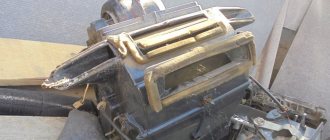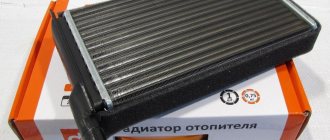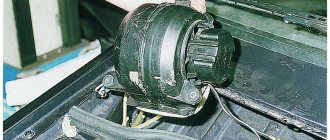The presence of air in the car's cooling system causes problems with engine overheating and ineffective operation of the interior heater. This article will present 4 methods by which it will become clear how to expel air from the cooling system of a VAZ 2114. The methods for solving the problem described in this article can be used on the entire family of first and second Samaras.
Useful video:
Signs of air in the engine cooling system
All signs of air in the cooling system and finding the cause: video
Since it is visually impossible to find out whether there is air in the cooling system, it is necessary to focus on indirect signs indicating the likely presence of plugs.
The main signs of air in the cooling system:
- Poor operation of the stove . The main sign of air in the cooling system is poor performance of the heater when the engine is warm. The supply of warm air after increasing the speed to 3000 rpm and above often indicates wear on the pump.
- Quick engine warm-up .
If there is a plug, it worsens the cooling process of the engine, which is why the internal combustion engine quickly warms up and the temperature rises above the operating temperature. The radiator will remain cold or warm. A common root cause of this symptom is a thermostat stuck in the closed position. Signs of antifreeze leakage - Low antifreeze level . A low level of antifreeze can itself cause a plug to form due to air leaking from the tank or indicate the presence of leaks.
- Traces of antifreeze leaks . Wet spots, dried white smudges on the pipes, engine, tank and other components located next to them are a sign of a leaky system.
- White smoke from the exhaust . This symptom, along with a drop in the coolant level, indicates that antifreeze has entered the combustion chamber through a broken cylinder head gasket. Through it, gases from the cylinder block can enter the cooling system.
How to determine whether the cooling system is airy
Having discovered the above signs of airing in the engine cooling system, it is necessary to determine the reason for their appearance in the following sequence:
- Inspect the cap of the expansion tank or radiator, disassembling it if possible. If there are obvious defects (cracked gasket, broken spring, etc.), replace the part with a new one, remove the plug and check if it appears again.
When an air lock occurs in the engine cooling system due to a faulty cap, the symptoms of airing are often accompanied by swelling of the tank and flattening of the pipes after the internal combustion engine has completely cooled.How to look for the cause of air in the cooling system using the example of Lada Kalina: video
- Inspect the radiator and cooling system pipes, their joints, for delaminations and cracks. Check the tightness of the clamps and make sure there are no cracks in the hoses. Sometimes antifreeze may not seep through small cracks, but air from the atmosphere enters through them as pressure drops.
- Check the operation of the pump by listening to its noise and inspecting the mount for coolant leaks. You can check the operation of the pump by pressing your hand on the pipe going to the radiator while the engine is running - pulsations of the liquid inside should be felt.
- With the engine warm, check whether bubbles appear in the expansion tank during throttle acceleration up to 3000 rpm.
Their presence often indicates a breakthrough of gases from the engine. If the coolant level gradually decreases and white smoke comes out of the exhaust pipe, there is a high probability of problems with the cylinder head gasket. Unscrewing the reservoir cap on an engine that has already warmed up to operating temperature is dangerous, since in the presence of excess pressure, hot antifreeze may be released. If it is impossible to check the presence of bubbles through the walls, it is better to unscrew the plug before the engine warms up. - Compare the temperatures of the upper and lower radiator hoses during warm-up. If on a warm engine the upper hose is hot and the lower hose is cold, most likely the reason lies in a malfunction of the thermostat.
Method 1
When starting to consider ways to remove an air lock from the cooling system of a VAZ 2114, the first step is to consider the easiest option. This method is based on physics. Because air in a liquid always tends to the top, you can put the front of the car on a hill, then unscrew the cap of the expansion tank and wait for the air to come out. Also, when lifting the car, you need to warm up the engine.
Adding gas will speed up the process of air leaving the system. Also, in the process of removing the plug, you need to switch the stove to the hottest mode and turn on the first fan speed. This method does not always help, because... it all depends on the location of the plug in the circuit. If there are leaks from the pipes or from under the thermostat, this method will only give a temporary effect, because the circuit will become leaky and will take in air again. Since it is not always possible to remove an air lock from the cooling system the first time, you can use other methods.
The first signs of a malfunction indicating a problem
Almost every experienced car owner of a domestic vehicle knows how to remove air from the VAZ-2115 stove. The fact is that, as practice shows, this phenomenon occurs quite often and is periodic.
Most often, the malfunction occurs due to the mistakes of the motorist himself, who incorrectly adds or changes the coolant. Less commonly, the problem occurs if:
- suction, which is present at the junction of the pipes;
- atmospheric valve defect;
- pump depressurization;
- leaks that occur in radiators.
However, no matter what technical side of the issue forces the car owner to get rid of the airlock, it should be remembered that if this problem is present, the engine will take too long to warm up and cool down. Due to airiness, the coolant will not move normally to the cooling radiator, which will lead to overheating of the power unit.
Methods for expelling air from the VAZ-2115 stove
If a motorist has diagnosed his car and realized that his VAZ-2115 heater is blown, he should use at least one of the methods below, which are considered quite effective solutions to the problem.
First method (blowing out the system)
According to the very first method, the motorist needs to dismantle the plastic casing covering the vehicle’s power unit. To remove this structural element, you will have to unscrew the cap covering the hole for adding oil. Then you need to remove the cover. It is worth noting that immediately after removing the protective casing, the cover should be returned to its place, which will preserve the cleanliness of the power unit by preventing the possibility of dirt and dust from entering.
The next step, which can solve the problem of airiness in the system, should be to search for the pipes responsible for warming up the throttle assembly. At this stage, it is necessary to pull off any pipe and, having twisted the lid from the hole in the container with antifreeze, cover the resulting “hole” with a clean rag.
To get rid of the malfunction, you will have to actively blow out the internal space of the tank. Through such actions, pressure is created, which pushes the collected air out. The need to stop the procedure should be indicated by the antifreeze coming from the pipe, since it will begin to come out only after there are no air accumulations left in the system.
After blowing out the VAZ-2115 system, the tube must be returned to its original place, and you should not hesitate, everything should be done as quickly as possible, otherwise a “portion” of unnecessary air will again appear in the tank.
Second method
If the VAZ-2115 stove is very airy, you can get rid of the resulting plug in just a few minutes without blowing out the system. To expel the accumulation of air, after actively warming up the power unit for 15 minutes, turn it off and, with the expansion tank cap closed, remove any pipe on the throttle assembly. After antifreeze or antifreeze starts coming out, you need to quickly insert the pipe into its original place. However, when using this method, one should not forget that after the power unit was running, the antifreeze could warm up to 80 °C.
Third method
The instructions described below will most likely help anyone whose VAZ-2115 stove is airy. To clean the system, you must first place the car at an angle; for this, a steep hill is suitable; the vehicle should stand with its nose at the highest point. After the car is put on the handbrake, and special stands are installed under all the wheels to protect the driver from unexpected rolling, you need to twist the plugs that close the holes on the radiator and expansion tank.
The power unit must be activated for at least 10 minutes so that it has time to warm up, then you need to press the accelerator pedal periodically, while adding coolant to the system.
Topping up antifreeze or antifreeze should be done until bubbles stop appearing. After they completely disappear, the work can be completed.
Method 2
A more sophisticated and effective way to get rid of a traffic jam is to create pressure in the system by the owner of the car himself. Briefly, the essence of the method is the following steps:
- Unscrew the engine oil filler cap;
- Remove the rubber gasket from it and return the cover to its place;
- Next, unscrew the cap from the expansion tank;
- Release one of the tubes leading to the throttle from the clamp and remove it from the metal pipe;
- Cover the neck of the tank with your mouth and blow into it, creating pressure in the circuit;
- After the antifreeze begins to flow out of the pipe without bubbles, put it in place and tighten it with a clamp;
- Reassemble the removed parts in reverse order.
This method may seem unsafe, because... There is a risk of inhaling antifreeze vapors when blowing air, but at low temperatures this procedure is safe. If the cooling system is still not free of the plug, use the following method.











